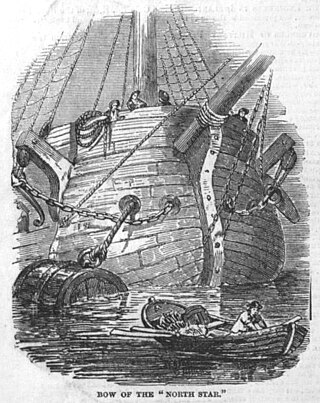
Sir William Edward Parry was a Royal Navy officer and explorer best known for his 1819–1820 expedition through the Parry Channel, probably the most successful in the long quest for the Northwest Passage, until it was finally negotiated by Roald Amundsen in 1906. In 1827, Parry attempted one of the earliest expeditions to the North Pole. He reached 82° 45' N, setting a record for human exploration Farthest North that stood for nearly five decades before being surpassed at 83° 20' N by Albert Hastings Markham in 1875.

Frederick William Beechey was an English naval officer, artist, explorer, hydrographer and writer.

George Francis Lyon was an English naval officer and explorer of Africa and the Arctic. While not having a particularly distinguished career, he is remembered for the entertaining journals he kept and for the pencil drawings he completed in the Arctic; this information was useful to later expeditions.

HMS Hecla was a Royal Navy Hecla-class bomb vessel launched in 1815. Like many other bomb vessels, she was named for a volcano, in this case Hekla in southern Iceland. She served at the Bombardment of Algiers in 1816. Subsequently, she took part in three expeditions to the Arctic. She then served as a survey vessel on the coast of West Africa until she was sold in 1831. She became a merchantman and in 1834 a Greenland whaler. She was wrecked in 1840.

HMS Fury was a Hecla-class bomb vessel of the British Royal Navy.

The Hecla class was a class of bomb vessels of the Royal Navy of the early 19th century. They were designed for use as bomb or mortar ships and were very heavily built. Eight ships were launched; all were converted for use as exploration or survey ships. Four ships of the class are known for the role they played in Arctic and Antarctic exploration.
Henry Foster was a British naval officer and scientist who took part in expeditions to both the Arctic and Antarctic, and made various notable scientific observations.

The Cherokee class was a class of brig-sloops of the Royal Navy, mounting ten guns. Brig-sloops were sloops-of-war with two masts rather than the three masts of ship sloops. Orders for 115 vessels were placed, including five which were cancelled and six for which the orders were replaced by ones for equivalent steam-powered paddle vessels.
Captain Henry Parkyns Hoppner was an officer of the Royal Navy, Arctic explorer, draughtsman and artist. His career included two ill-fated voyages culminating in the loss of HMS Alceste in 1816 and HMS Fury in 1825.

HMS Assistance was an Arctic discovery barque of the Royal Navy, and the sixth vessel to carry the name. She began in 1834 as the India-built merchant vessel Acorn. Her name was changed to Baboo. Under that name she transported contract labourers between Mauritius and India, and immigrants to South Australia. The Royal Navy purchased her in 1850 and named her HMS Assistance. Assistance participated in two Arctic expeditions before her crew abandoned her in the ice in 1854.

A nautical chronometer made by Thomas Earnshaw (1749–1828), and once part of the equipment of HMS Beagle, the ship that carried Charles Darwin on his voyage around the world, is held in the British Museum. The chronometer was the subject of one episode of the BBC's series A History of the World in 100 Objects.

The Atholl-class corvettes were a series of fourteen Royal Navy sailing sixth-rate post ships built to an 1817 design by the Surveyors of the Navy. A further four ships ordered to this design were cancelled.

HMS Herald was an Atholl-class 28-gun sixth-rate corvette of the Royal Navy. She was launched in 1822 as HMS Termagant, commissioned in 1824 as HMS Herald and converted to a survey ship in 1845. After serving as a chapel ship from 1861, she was sold for breaking in 1862.
Captain Douglas Charles Clavering RN FRS was an officer of the British Royal Navy and Arctic explorer.

HMS Swan was launched on 21 November 1767 at Plymouth as the lead ship of the 24 ships in the 14-gun Swan-class of ship-sloops built in the 1760s and 1770s. She served during the American Revolutionary War and the French Revolutionary War. She bore the name HMS Explosion between 1779 and 1783; at the time she was classed as a fireship. She was laid up in 1801 and finally sold in 1814. Swan then became a whaler in the northern whale fishery, sailing out of Kingston-on-Hull. She also made one voyage to the southern whale fishery (1819–1821) and one merchant voyage to Brazil and Hamburg, before returning to the northern whale fishery. She was broken up circa. 1841.

HMS North Star was a 28-gun Atholl-class sixth-rate post ship built to an 1817 design by the Surveyors of the Navy. She was launched in 1824. North Star Bay, a bay in Greenland, was named in honour of this ship.

HMS Meteor was a Hecla-class bomb vessel built for the Royal Navy during the 1820s. In July 1832 she was renamed Beacon and reclassified as a survey ship, and was sold in 1846.
Anacreon was launched in 1800 at Sunderland. She initially sailed between London and Minorca and then between 1804 and 1805 she served as an armed defense ship for the Royal Navy. She next became a London-based transport, and eventually traded from Liverpool to the Baltic and Canada. She was wrecked in 1823.

HMS Seringapatam was a 46-gun Seringapatam-class fifth-rate frigate built for the Royal Navy between 1817 and 1821, the name ship of her class.
Achilles was launched in 1813 at Shields. She sailed from Shields to London and then operated for some years as a transport. She later traded more generally. In 1820 new owners moved her to Dundee. She became a whaler in the British northern whale fishery until she was lost there in 1830.















